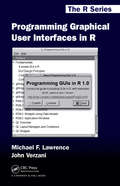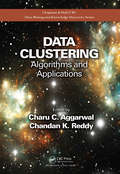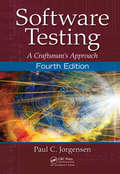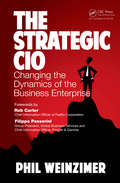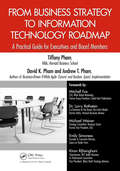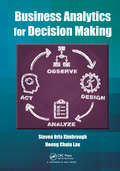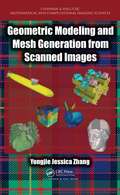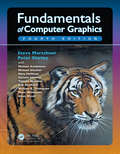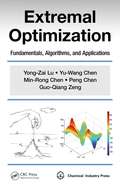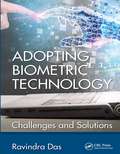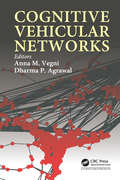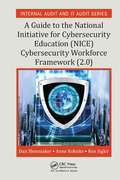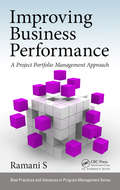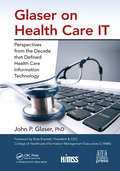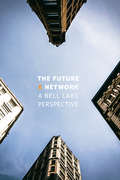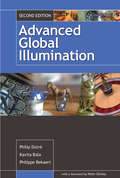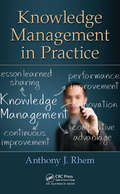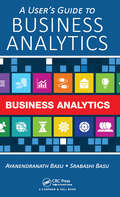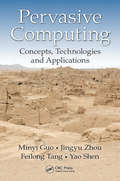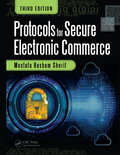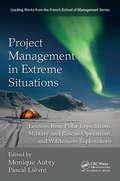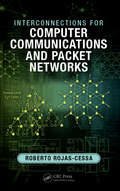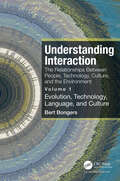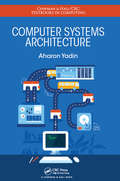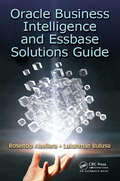- Table View
- List View
Programming Graphical User Interfaces in R (Chapman & Hall/CRC The R Series #5)
by Michael Lawrence John VerzaniProgramming Graphical User Interfaces with R introduces each of the major R packages for GUI programming: RGtk2, qtbase, Tcl/Tk, and gWidgets. With examples woven through the text as well as stand-alone demonstrations of simple yet reasonably complete applications, the book features topics especially relevant to statisticians who aim to provide a practical interface to functionality implemented in R. The book offers: A how-to guide for developing GUIs within R The fundamentals for users with limited knowledge of programming within R and other languages GUI design for specific functions or as learning tools The accompanying package, ProgGUIinR, includes the complete code for all examples as well as functions for browsing the examples from the respective chapters. Accessible to seasoned, novice, and occasional R users, this book shows that for many purposes, adding a graphical interface to one’s work is not terribly sophisticated or time consuming.
Data Clustering: Algorithms and Applications (Chapman & Hall/CRC Data Mining and Knowledge Discovery Series #31)
by Charu C. Aggarwal Chandan K. ReddyResearch on the problem of clustering tends to be fragmented across the pattern recognition, database, data mining, and machine learning communities. Addressing this problem in a unified way, Data Clustering: Algorithms and Applications provides complete coverage of the entire area of clustering, from basic methods to more refined and complex data clustering approaches. It pays special attention to recent issues in graphs, social networks, and other domains.The book focuses on three primary aspects of data clustering: Methods, describing key techniques commonly used for clustering, such as feature selection, agglomerative clustering, partitional clustering, density-based clustering, probabilistic clustering, grid-based clustering, spectral clustering, and nonnegative matrix factorization Domains, covering methods used for different domains of data, such as categorical data, text data, multimedia data, graph data, biological data, stream data, uncertain data, time series clustering, high-dimensional clustering, and big data Variations and Insights, discussing important variations of the clustering process, such as semisupervised clustering, interactive clustering, multiview clustering, cluster ensembles, and cluster validation In this book, top researchers from around the world explore the characteristics of clustering problems in a variety of application areas. They also explain how to glean detailed insight from the clustering process—including how to verify the quality of the underlying clusters—through supervision, human intervention, or the automated generation of alternative clusters.
Software Testing: A Craftsman’s Approach, Fourth Edition
by Paul C. JorgensenThis updated and reorganized fourth edition of Software Testing: A Craftsman's Approach applies the strong mathematics content of previous editions to a coherent treatment of Model-Based Testing for both code-based (structural) and specification-based (functional) testing. These techniques are extended from the usual unit testing discussions to full coverage of less understood levels integration and system testing. The Fourth Edition: Emphasizes technical inspections and is supplemented by an appendix with a full package of documents required for a sample Use Case technical inspection Introduces an innovative approach that merges the Event-Driven Petri Nets from the earlier editions with the "Swim Lane" concept from the Unified Modeling Language (UML) that permits model-based testing for four levels of interaction among constituents in a System of Systems Introduces model-based development and provides an explanation of how to conduct testing within model-based development environments Presents a new section on methods for testing software in an Agile programming environment Explores test-driven development, reexamines all-pairs testing, and explains the four contexts of software testing Thoroughly revised and updated, Software Testing: A Craftsman’s Approach, Fourth Edition is sure to become a standard reference for those who need to stay up to date with evolving technologies in software testing. Carrying on the tradition of previous editions, it will continue to serve as a valuable reference for software testers, developers, and engineers.
The Strategic CIO: Changing the Dynamics of the Business Enterprise
by Philip WeinzimerRecognized as One of the Best Business Books for 2014 by CIO Magazine Based on interviews with more than 150 CIOs, IT/business executives, and academic thought leaders, The Strategic CIO: Changing the Dynamics of the Business Enterprise provides insight, success stories, and a step-by-step methodology to transform your IT organization into a strategic asset that drives customer value, increases revenues, and enhances shareholder wealth. The book details how strategic CIOs from FedEx, Procter & Gamble, McKesson, and other leading companies transformed their organizations. It illustrates the methods these CIOS used to become strategic partners that collaborate effectively within their organizations to leverage information and technology for a competitive advantage.The text will help you assess the key competencies and skills required by IT personnel to partner with your business teams to create new and enhanced products and services that create customer value, increase margin, and enhance shareholder wealth.The book includes powerful methodologies, time-saving templates, proven best practices, and helpful assessments. It also details a four-phase methodology, along with the associated activities and tools, to help your IT organization successfully transform into a strategic IT organization.Gain insight into the four domain competencies and twelve associated skills required to build effective strategic IT organizations. Build your roadmap to success using the transformation methodology described in the text and you will be on your way to making your organization a strategic IT organization. Read Philip Weinzimer’s recent article that appeared on CIO.com.
From Business Strategy to Information Technology Roadmap: A Practical Guide for Executives and Board Members
by Tiffany Pham David K. Pham Andrew PhamWhether you are a CEO, CFO, board member, or an IT executive, From Business Strategy to Information Technology Roadmap: A Practical Guide for Executives and Board Members lays out a practical, how-to approach to identifying business strategies and creating value-driven technology roadmaps in your organization. Unlike many other books on the subject, you will not find theories or grandiose ideas here. This book uses numerous examples, illustrations, and case studies to show you how to solve the real-world problems that business executives and technology leaders face on a day-to-day basis.Filled with actionable advice you can use immediately, the authors introduce Agile and the Lean mindset in a manner that the people in your business and technology departments can easily understand. Ideal for executives in both the commercial and nonprofit sectors, it includes two case studies: one about a commercial family business that thrived to become a multi-million-dollar company and the other about a nonprofit association based in New York City that fights against child illiteracy.
Business Analytics for Decision Making
by Steven Orla Kimbrough Hoong Chuin LauBusiness Analytics for Decision Making, the first complete text suitable for use in introductory Business Analytics courses, establishes a national syllabus for an emerging first course at an MBA or upper undergraduate level. This timely text is mainly about model analytics, particularly analytics for constrained optimization. It uses implementations that allow students to explore models and data for the sake of discovery, understanding, and decision making.Business analytics is about using data and models to solve various kinds of decision problems. There are three aspects for those who want to make the most of their analytics: encoding, solution design, and post-solution analysis. This textbook addresses all three. Emphasizing the use of constrained optimization models for decision making, the book concentrates on post-solution analysis of models. The text focuses on computationally challenging problems that commonly arise in business environments. Unique among business analytics texts, it emphasizes using heuristics for solving difficult optimization problems important in business practice by making best use of methods from Computer Science and Operations Research. Furthermore, case studies and examples illustrate the real-world applications of these methods. The authors supply examples in Excel®, GAMS, MATLAB®, and OPL. The metaheuristics code is also made available at the book's website in a documented library of Python modules, along with data and material for homework exercises. From the beginning, the authors emphasize analytics and de-emphasize representation and encoding so students will have plenty to sink their teeth into regardless of their computer programming experience.
Geometric Modeling and Mesh Generation from Scanned Images (Chapman & Hall/CRC Mathematical and Computational Imaging Sciences Series #6)
by Yongjie Jessica ZhangCutting-Edge Techniques to Better Analyze and Predict Complex Physical Phenomena Geometric Modeling and Mesh Generation from Scanned Images shows how to integrate image processing, geometric modeling, and mesh generation with the finite element method (FEM) to solve problems in computational biology, medicine, materials science, and engineering. Based on the author’s recent research and course at Carnegie Mellon University, the text explains the fundamentals of medical imaging, image processing, computational geometry, mesh generation, visualization, and finite element analysis. It also explores novel and advanced applications in computational biology, medicine, materials science, and other engineering areas. One of the first to cover this emerging interdisciplinary field, the book addresses biomedical/material imaging, image processing, geometric modeling and visualization, FEM, and biomedical and engineering applications. It introduces image-mesh-simulation pipelines, reviews numerical methods used in various modules of the pipelines, and discusses several scanning techniques, including ones to probe polycrystalline materials. The book next presents the fundamentals of geometric modeling and computer graphics, geometric objects and transformations, and curves and surfaces as well as two isocontouring methods: marching cubes and dual contouring. It then describes various triangular/tetrahedral and quadrilateral/hexahedral mesh generation techniques. The book also discusses volumetric T-spline modeling for isogeometric analysis (IGA) and introduces some new developments of FEM in recent years with applications.
Fundamentals of Computer Graphics (Fourth Edition)
by Peter Shirley Steve MarschnerDrawing on an impressive roster of experts in the field, Fundamentals of Computer Graphics, Fourth Edition offers an ideal resource for computer course curricula as well as a user-friendly personal or professional reference. Focusing on geometric intuition, the book gives the necessary information for understanding how images get onto the screen by using the complementary approaches of ray tracing and rasterization. It covers topics common to an introductory course, such as sampling theory, texture mapping, spatial data structure, and splines. It also includes a number of contributed chapters from authors known for their expertise and clear way of explaining concepts. Highlights of the Fourth Edition Include: Updated coverage of existing topics Major updates and improvements to several chapters, including texture mapping, graphics hardware, signal processing, and data structures A text now printed entirely in four-color to enhance illustrative figures of concepts The fourth edition of Fundamentals of Computer Graphics continues to provide an outstanding and comprehensive introduction to basic computer graphic technology and theory. It retains an informal and intuitive style while improving precision, consistency, and completeness of material, allowing aspiring and experienced graphics programmers to better understand and apply foundational principles to the development of efficient code in creating film, game, or web designs.
Extremal Optimization: Fundamentals, Algorithms, and Applications
by Yong-Zai Lu Yu-Wang Chen Min-Rong Chen Peng Chen Guo-Qiang ZengExtremal Optimization: Fundamentals, Algorithms, and Applications introduces state-of-the-art extremal optimization (EO) and modified EO (MEO) solutions from fundamentals, methodologies, and algorithms to applications based on numerous classic publications and the authors’ recent original research results. It promotes the movement of EO from academic study to practical applications. The book covers four aspects, beginning with a general review of real-world optimization problems and popular solutions with a focus on computational complexity, such as "NP-hard" and the "phase transitions" occurring on the search landscape. Next, it introduces computational extremal dynamics and its applications in EO from principles, mechanisms, and algorithms to the experiments on some benchmark problems such as TSP, spin glass, Max-SAT (maximum satisfiability), and graph partition. It then presents studies on the fundamental features of search dynamics and mechanisms in EO with a focus on self-organized optimization, evolutionary probability distribution, and structure features (e.g., backbones), which are based on the authors’ recent research results. Finally, it discusses applications of EO and MEO in multiobjective optimization, systems modeling, intelligent control, and production scheduling. The authors present the advanced features of EO in solving NP-hard problems through problem formulation, algorithms, and simulation studies on popular benchmarks and industrial applications. They also focus on the development of MEO and its applications. This book can be used as a reference for graduate students, research developers, and practical engineers who work on developing optimization solutions for those complex systems with hardness that cannot be solved with mathematical optimization or other computational intelligence, such as evolutionary computations.
Adopting Biometric Technology: Challenges and Solutions
by Ravindra DasMany types of security technologies are currently in use, with biometrics being one of the latest and most cutting-edge forms that has been produced for mass application. Biometrics, while intriguing, is often broached with hesitation and poor understanding. Adopting Biometric Technology: Challenges and Solutions advocates increased implementation of biometric technology areas of the world where it has been least accepted, particularly in the United States. This book looks at several specific applications of biometric technology, challenging issues that have obstructed the use of biometrics in security and offering realistic solutions for increasing its worldwide utilization. It is divided into three sections, with the first discussing societal barriers against the adoption of biometric technology in security. The second section presents case studies of specific applications, such as e-passports and e-voting, that have already been implemented and could be expanded into regions where usage is low. The third section lays out a case for the general practicality and value that biometrics offers to relevant business sectors, including the benefits of implementing the currently controversial technology in place of the conventional forms of verification. While biometric technology has been poorly accepted and adopted in the United States as well as other developed nations, it is already a popular tool in developing nations in Asia, Africa, and Eastern Europe. Adopting Biometric Technology examines the societal resistance hindering the broader usage of biometrics and provides practical solutions for overcoming those barriers while showing how its increased application would be overall advantageous.
Cognitive Vehicular Networks
by Anna Maria Vegni Dharma P. AgrawalA comprehensive text on both current and emerging areas of cognitive vehicular networks, this book focuses on a new class of mobile ad hoc networks. It uses a pedagogical approach utilizing cognitive aspects applied to vehicular environments and comprises contributions from well-known and high profile researchers in their respective specialties. The book provides significant technical and practical insights on different perspectives, starting from a basic background on cognitive radio, interrelated technologies, application to vehicular networks, technical challenges, and future trends.
A Guide to the National Initiative for Cybersecurity Education: A Guide To The National Initiative For Cybersecurity Education (nice) Framework (2. 0) (Security, Audit and Leadership Series)
by Dan Shoemaker Anne Kohnke Ken SiglerA Guide to the National Initiative for Cybersecurity Education (NICE) Cybersecurity Workforce Framework (2.0) presents a comprehensive discussion of the tasks, knowledge, skill, and ability (KSA) requirements of the NICE Cybersecurity Workforce Framework 2.0. It discusses in detail the relationship between the NICE framework and the NIST’s cybersecurity framework (CSF), showing how the NICE model specifies what the particular specialty areas of the workforce should be doing in order to ensure that the CSF’s identification, protection, defense, response, or recovery functions are being carried out properly. The authors construct a detailed picture of the proper organization and conduct of a strategic infrastructure security operation, describing how these two frameworks provide an explicit definition of the field of cybersecurity. The book is unique in that it is based on well-accepted standard recommendations rather than presumed expertise. It is the first book to align with and explain the requirements of a national-level initiative to standardize the study of information security. Moreover, it contains knowledge elements that represent the first fully validated and authoritative body of knowledge (BOK) in cybersecurity. The book is divided into two parts: The first part is comprised of three chapters that give you a comprehensive understanding of the structure and intent of the NICE model, its various elements, and their detailed contents. The second part contains seven chapters that introduce you to each knowledge area individually. Together, these parts help you build a comprehensive understanding of how to organize and execute a cybersecurity workforce definition using standard best practice.
Improving Business Performance: A Project Portfolio Management Approach (Best Practices in Portfolio, Program, and Project Management)
by Ramani SNo organization is impervious to change. Rather, the survival and growth of an organization is dependent on how well it copes with change. Successful change initiatives consist of the integrated eco-system of its portfolio, programs, and projects. These change initiatives become the delivery mechanisms for implementing the strategy of an organization.Improving Business Performance: A Project Portfolio Management Approach clarifies how the proper application of portfolio, program, and project management concepts can help commercial and non-profit organizations achieve their strategic objectives. Most organizations have been good at devising strategy, but falter during its implementation. Executing strategy well to deliver superior business performance remains a key challenge, which is addressed as the core theme of this book.The book portrays a top-down orientation as well as a bottom-up integration of change initiatives to facilitate alignment to strategy and accommodate mid-course changes. It takes into account existing global best management practices to bring forth an approach that is customizable and useful to organizations in any industry.Describing why portfolio management lies at the apex of change initiative management, the book explains how to design and fine-tune portfolios so they are in alignment with your organization’s overall strategy and business needs. After reading this book, you will understand: How to design the project portfolio structure for your organization How to integrate programs and projects within the portfolio more effectively How to better manage interactions across diverse change initiatives How to maintain focus while managing change to realize benefits The book presents a case study that illustrates the application of project portfolio concepts in practical scenarios. It includes chapters dedicated to transition management, change management, benefits management, and the Enterprise Project Management Office. It also includes templates you can immediately put to use in your own portfolios, programs, and projects.
Glaser on Health Care IT: Perspectives from the Decade that Defined Health Care Information Technology (HIMSS Book Series)
by John P. GlaserJohn Glaser has been an astute observer and recognized leader in the health care industry for over thirty years. He has written a regular column for Hospitals & Health Networks in which he comments on a wide range of topics, including improving organizational performance through health information technology (HIT), changes in HIT architecture, challenges in leveraging data, and the evolution of the role of IT leadership. Glaser on Health Care IT: Perspectives from the Decade that Defined Health Care Information Technology is a collection of some of the most widely read articles that have been published in H&HN Daily, H&HN Weekly, and Most Wired Online in the past decade (2005–2015). The columns are dated to show their original publication dates, and the material is organized into four broad themes: HIT Applications and Analytics Challenges Improving Organizational Performance through HIT IT Management Challenges HIT Industry Observations Each section offers readers an intimate look at the myriad issues associated with getting IT "right" and the organizational performance gains that can be achieved in doing so. Moreover, the book examines the power and potential of the technologies available to health care providers today, as well as the transformative nature of those we have yet to fully embrace.From seasoned CIOs and consultants to software developers and nurses, this book provides invaluable insights and guidance to all those seeking to make the delivery of care safer, more effective, and more efficient through the application of health care IT.Foreword by Russ Branzell, President and CEO, College of Healthcare Information Management Executives (CHIME) Co-published with Health Forum, Inc.
The Future X Network: A Bell Labs Perspective
by Marcus K. WeldonWe are at the dawn of an era in networking that has the potential to define a new phase of human existence. This era will be shaped by the digitization and connection of everything and everyone with the goal of automating much of life, effectively creating time by maximizing the efficiency of everything we do and augmenting our intelligence with knowledge that expedites and optimizes decision-making and everyday routines and processes.The Future X Network: A Bell Labs Perspective outlines how Bell Labs sees this future unfolding and the key technological breakthroughs needed at both the architectural and systems levels. Each chapter of the book is dedicated to a major area of change and the network and systems innovation required to realize the technological revolution that will be the essential product of this new digital future.
Advanced Global Illumination
by Philip Dutre Philippe Bekaert Kavita BalaThis book provides a fundamental understanding of global illumination algorithms. It discusses a broad class of algorithms for realistic image synthesis and introduces a theoretical basis for the algorithms presented. Topics include: physics of light transport, Monte Carlo methods, general strategies for solving the rendering equation, stochastic path-tracing algorithms such as ray tracing and light tracing, stochastic radiosity including photon density estimation and hierarchical Monte Carlo radiosity, hybrid algorithms, metropolis light transport, irradiance caching, photon mapping and instant radiosity, beyond the rendering equation, image display and human perception. If you want to design and implement a global illumination rendering system or need to use and modify an existing system for your specific purpose, this book will give you the tools and the understanding to do so.
Knowledge Management in Practice
by Anthony J. Rhem"This evidence-based book provides the framework and guidelines that professionals need for working with the contemporary explosion of data that is creating opportunities and challenges to all phases of our society and commerce." –Larry R. Medsker, Research Professor in Physics and Data Science, The George Washington University Knowledge Management in Practice is a resource on how knowledge management (KM) is implemented. It provides specific KM methods, tips, techniques, and best practices to gain competitive advantage and the most from investing in KM. It examines how KM is leveraged by first responders, the military, healthcare providers, insurance and financial services companies, legal firms, human resources departments, merger and acquisition (M&A) firms, and research institutions. Essential KM concepts are explored not only from a foundational perspective but also from a practical application. These concepts include capturing and codifying tacit and explicit knowledge, KM methods, information architecture, search, KM and social media, KM and Big Data, and the adoption of KM. Readers can visit the book’s companion website, KM Mentor (www.KMMentor.com), where they can access: Presentations by industry leaders on a variety of topics KM templates and instruction on executing KM strategy, performing knowledge transfer, and KM assessments and audits KM program and project implementation guidance Insights and reviews on KM tools Guidance on implementing and executing various KM Methods Specialized KM publications A private secure collaboration community for members to discuss ideas and get expert answers and advice
A User's Guide to Business Analytics
by Ayanendranath Basu Srabashi BasuA User's Guide to Business Analytics provides a comprehensive discussion of statistical methods useful to the business analyst. Methods are developed from a fairly basic level to accommodate readers who have limited training in the theory of statistics. A substantial number of case studies and numerical illustrations using the R-software package are provided for the benefit of motivated beginners who want to get a head start in analytics as well as for experts on the job who will benefit by using this text as a reference book. The book is comprised of 12 chapters. The first chapter focuses on business analytics, along with its emergence and application, and sets up a context for the whole book. The next three chapters introduce R and provide a comprehensive discussion on descriptive analytics, including numerical data summarization and visual analytics. Chapters five through seven discuss set theory, definitions and counting rules, probability, random variables, and probability distributions, with a number of business scenario examples. These chapters lay down the foundation for predictive analytics and model building. Chapter eight deals with statistical inference and discusses the most common testing procedures. Chapters nine through twelve deal entirely with predictive analytics. The chapter on regression is quite extensive, dealing with model development and model complexity from a user’s perspective. A short chapter on tree-based methods puts forth the main application areas succinctly. The chapter on data mining is a good introduction to the most common machine learning algorithms. The last chapter highlights the role of different time series models in analytics. In all the chapters, the authors showcase a number of examples and case studies and provide guidelines to users in the analytics field.
Pervasive Computing: Concepts, Technologies and Applications (Lecture Notes in Computer Science #6646)
by Minyi Guo Jingyu Zhou Feilong Tang Yao ShenThis book introduces fundamental concepts and theories in pervasive computing as well as its key technologies and applications. It explains how to design and implement pervasive middleware and real application systems, covering nearly all aspects related to pervasive computing. Key technologies in the book include pervasive computing-oriented resource management and task migration, mobile pervasive transaction, human computer interface, and context collection-oriented wireless sensor networks.
Protocols for Secure Electronic Commerce (Advanced And Emerging Communications Technologies Ser.)
by Mostafa Hashem SherifProtocols for Secure Electronic Commerce, Third Edition presents a compendium of protocols for securing electronic commerce, or e-commerce, in consumer- and business-to-business applications. Attending to a variety of electronic payment systems currently in use around the globe, this edition: <Li>Updates all chapters to reflect the latest technical advances and developments in areas such as mobile commerce <Li>Adds a new chapter on Bitcoin and other cryptocurrencies that did not exist at the time of the previous edition's publication <Li>Increases the coverage of PayPal in accordance with PayPal’s amplified role for consumers and businesses <Li>Expands the discussion of bank cards, dedicating a full chapter to magnetic stripe cards and a full chapter to chip-and-PIN technology <P><P>Protocols for Secure Electronic Commerce, Third Edition offers a state-of-the-art overview of best practices for the security of e-commerce, complete with end-of-chapter review questions and an extensive bibliography of specialized references. A Solutions Manual and PowerPoint slides are available with qualifying course adoption.
Project Management in Extreme Situations: Lessons from Polar Expeditions, Military and Rescue Operations, and Wilderness Exploration (Leading Works from the French School of Management)
by Monique Aubry Pascal LievreThe growing complexity of projects today, as well as the uncertainty inherent in innovative projects, is making obsolete traditional project management practices and procedures, which are based on the notion that much about a project is known at its start. The current high level of change and complexity confronting organizational leaders and managers requires a new approach to projects so they can be managed flexibly to embrace and exploit change. What once used to be considered extreme uncertainty is now the norm, and managing planned projects is being replaced by managing projects as they evolve. <P><P>Successfully managing projects in extreme situations, such as polar and military expeditions, shows how to manage successfully projects in today’s turbulent environment. Executed under the harshest and most unpredictable conditions, these projects are great sources for learning about how to manage unexpected and unforeseen situations as they occur. This book presents multiple case studies of managing extreme events as they happened during polar, mountain climbing, military, and rescue expeditions. <P><P>A boat accident in the Artic is a lesson on how an effective project manager must be ambidextrous: on one hand able to follow plans and on the other hand able to abandon those plans when disaster strikes and improvise new ones in response. Polar expeditions also illustrate how a team can use "weak links" to go beyond its usual information network to acquire strategic information. Fire and rescues operations illustrate how one team member’s knowledge can be transferred to the entire team. Military operations provide case material on how teams coordinate and make use of both individual and collective competencies. <P><P>This groundbreaking work pushes the definitions of a project and project management to reveal new insight that benefits researchers, academics, and the practitioners managing projects in today’s challenging and uncertain times.
Interconnections for Computer Communications and Packet Networks
by Roberto Rojas-CessaThis book introduces different interconnection networks applied to different systems. Interconnection networks are used to communicate processing units in a multi-processor system, routers in communication networks, and servers in data centers. Queuing techniques are applied to interconnection networks to support a higher utilization of resources. There are different queuing strategies, and these determine not only the performance of the interconnection network, but also the set of requirements to make them work effectively and their cost. Routing algorithms are used to find routes to destinations and directions in what information travels. Additional properties, such as avoiding deadlocks and congestion, are sought. Effective routing algorithms need to be paired up with these networks. The book will introduce the most relevant interconnection networks, queuing strategies, and routing algorithm. It discusses their properties and how these leverage the performance of the whole interconnection system. In addition, the book covers additional topics for memory management and congestion avoidance, used to extract higher performance from the interconnection network.
Understanding Interaction: Volume 1: Evolution, Technology, Language and Culture
by Bert BongersUnderstanding Interaction explores the interaction between people and technology in the broader context of the relations between the human-made and the natural environments. It is not just about digital technologies – our computers, smartphones, the Internet – but all our technologies, such as mechanical, electrical, and electronic. Our ancestors started creating mechanical tools and shaping their environments millions of years ago, developing cultures and languages, which in turn influenced our evolution. Volume 1 looks into this deep history, starting from the tool-creating period (the longest and most influential on our physical and mental capacities) to the settlement period (agriculture, domestication, villages and cities, written language), the industrial period (science, engineering, reformation, and renaissance), and finally the communication period (mass media, digital technologies, and global networks). Volume 2 looks into humans in interaction – our physiology, anatomy, neurology, psychology, how we experience and influence the world, and how we (think we) think. From this transdisciplinary understanding, design approaches and frameworks are presented to potentially guide future developments and innovations. The aim of the book is to be a guide and inspiration for designers, artists, engineers, psychologists, media producers, social scientists, etc., and, as such, be useful for both novices and more experienced practitioners. Image Credit: Still of interactive video pattern created with a range of motion sensors in the Facets kaleidoscopic algorithm (based underwater footage of seaweed movement) by the author on 4 February 2010, for a lecture at Hyperbody at the Faculty of Architecture, TU Delft, NL.
Computer Systems Architecture (Chapman & Hall/CRC Textbooks in Computing)
by Aharon YadinComputer Systems Architecture provides IT professionals and students with the necessary understanding of computer hardware. It addresses the ongoing issues related to computer hardware and discusses the solutions supplied by the industry. The book describes trends in computing solutions that led to the current available infrastructures, tracing the initial need for computers to recent concepts such as the Internet of Things. It covers computers’ data representation, explains how computer architecture and its underlying meaning changed over the years, and examines the implementations and performance enhancements of the central processing unit (CPU). It then discusses the organization, hierarchy, and performance considerations of computer memory as applied by the operating system and illustrates how cache memory significantly improves performance. The author proceeds to explore the bus system, algorithms for ensuring data integrity, input and output (I/O) components, methods for performing I/O, various aspects relevant to software engineering, and nonvolatile storage devices, such as hard drives and technologies for enhancing performance and reliability. He also describes virtualization and cloud computing and the emergence of software-based systems’ architectures. Accessible to software engineers and developers as well as students in IT disciplines, this book enhances readers’ understanding of the hardware infrastructure used in software engineering projects. It enables readers to better optimize system usage by focusing on the principles used in hardware systems design and the methods for enhancing performance.
Oracle Business Intelligence and Essbase Solutions Guide
by Lakshman Bulusu Rosendo AbelleraThis book highlights the practical aspects of using Oracle Essbase and Oracle Business Intelligence Enterprise Edition (OBIEE) as a comprehensive BI solution. It explains the key steps involved in Oracle Essbase and OBIEE implementations. Using case studies, the book covers Oracle Essbase for analytical BI and data integration, using OBIEE for operational BI including presentation services and BI Publisher for real-time reporting services, Self-service BI– in terms of VLDB, scalability, high performance, stability, long-lasting and ease of use that saves time, effort, and costs, while maximizing ROI.
